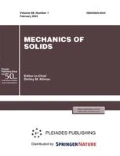Abstract
We consider the results of known tests of tubular specimens under a constant axial stress and a constant or alternating tangential stress. The cyclic variation in the sign of the tangential stresses significantly increases the time to fracture.
The modeling of long-term strength of metals in unsteady complex stress states encounters significant difficulties. The application of the kinetic theory of long-term strength is apparently the most promising method for solving this problem. As a rule, the use of a scalar damage parameter does not permit describing the specific characteristics of fracture for various loading programs. The use of a tensor damage parameter also encounters difficulties because of a large number of functions and material constants contained in the kinetic equations. In this paper, we propose to use a vector damage parameter to describe the experimental data under study.
Similar content being viewed by others
References
L.M. Kachanov, “On the Time of Fracture in Creep,” Izv. Akad. Nauk SSSR. OTN, No. 8, 26–31 (1958).
Yu. N. Rabotnov, “On the Mechanism of Long-Term Fracture,” in Problems of Strength of Materials and Structures (Izdat. AN SSSR,Moscow, 1959) [in Russian].
Yu. N. Rabotnov, Creep of Structural Members (Nauka, Moscow, 1966) [in Russian].
W. A. Trampezynski, D. R. Hayhurst, and F. A. Leckie, “Creep Rupture of Copper and Aluminum under Nonproportional Loading,” J. Mech. Phys. Solids 29 (5–6), 353–374 (1981).
F. Trivaudey and P. Delobelle, “High TemperatureCreep Damage under Biaxial Loading. Pt. 1. Experiments,” Trans. ASME. J. Engng Mater. Technol. 112 (4), 442–449 (1990).
A. M. Lokoshchenko, “Investigation ofMaterialDamage under Creep and Creep Strength,” Zh. Prikl.Mekh. Tekhn. Fiz., No. 6, 129–133 (1982) [J. Appl.Mech. Tech. Phys. (Engl. Transl.) 23 (6), 855–859 (1982)].
L. M. Kachanov, “Fracture in Creep under Complex Loading,” Izv. Akad. Nauk SSSR. Mekh. Tverd. Tela, No. 5, 11–15 (1972) [Mech. Solids (Engl. Transl.)].
L.M. Kachanov, Foundations of Fracture Mechanics (Nauka, Moscow, 1974) [in Russian].
A. M. Lokoshchenko, “Study of Long-TermStrength inComplex Stress State by a Kinetic Approach,” Trudy TsKTI, No. 230, 107–109 (1986).
A. M. Lokoshchenko, “Methods for Modeling of Long-Term Strength of Metals in Steady and Unsteady Complex Stress States,” in Elasticity and Inelasticity. Intern. Scientific Symposium in Problems of Mechanics of Deformable Solids Dedicated to A. A. Il’yushin on the Occasion of His 100th Birthday, January 20–21, 2011, Moscow (Izdat. MGU,Moscow, 2011), pp. 389–393 [in Russian].
A. M. Lokoshchenko and V. V. Nazarov, “Long-Term Strength of Metals under an Equiaxial Plane Stress State,” Zh. Prikl. Mekh. Tekhn. Fiz., No. 4, 150–157 (2009) [J. Appl. Mech. Tech. Phys. (Engl. Transl.) 50 (4), 670–676 (2009)].
Author information
Authors and Affiliations
Corresponding author
Additional information
Original Russian Text © A.M. Lokoshchenko, 2016, published in Izvestiya Akademii Nauk, Mekhanika Tverdogo Tela, 2016, No. 3, pp. 93–99.
About this article
Cite this article
Lokoshchenko, A.M. Use of a vector damage parameter in modeling of long-term strength of metals. Mech. Solids 51, 315–320 (2016). https://doi.org/10.3103/S0025654416030080
Received:
Published:
Issue Date:
DOI: https://doi.org/10.3103/S0025654416030080




